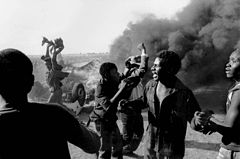| Part of Internal resistance to apartheid | |
 Anti-apartheid protestors in a South African township | |
| Location | South Africa |
|---|---|
| Participants | Vaal Civic Association United Democratic Front Congress of South African Students |
| Start date | 3 September 1984 |
| Deaths | 1,600 by June 1986 |
| Outcome |
|
| Part of a series on |
| Apartheid |
|---|
 |
The Vaal uprising was a period of popular revolt in black townships in apartheid South Africa, beginning in the Vaal Triangle on 3 September 1984. Sometimes known as the township revolt and driven both by local grievances and by opposition to apartheid, the uprising lasted two years and affected most regions of the country. The government of P. W. Botha did not succeed in curbing the violence until after it imposed a national state of emergency in June 1986.
The uprising began on 3 September in the Vaal Triangle, an industrial region south of Johannesburg, where the local Vaal Civic Association had organised a stay-away to protest rent increases. In the deadliest day of protesting since the 1976 Soweto uprising, there were an estimated 300 injuries and 29 fatalities, some of whom were black local councillors executed by protestors. Over the next year, civic associations and student organisations carried the riots to other areas of the country. From late 1984, in what marked a new phase of united mass action in opposition politics, protestors received support from the emerging trade union movement, including from the Federation of South African Trade Unions.
A primary target of the violence in townships were black local councillors, newly empowered by the Black Local Authorities Act. Also targeted were others viewed as collaborators of the apartheid system, such as black policemen, informants, and even school principals. A considerable number of those killed during the uprising were killed by protestors in acts of vigilante justice, including in some cases by necklacing, although many others were killed by state security forces or by rival vigilantes. Opposition to black local authorities constituted an intersection between local and socioeconomic grievances, on the one hand, and broad opposition to apartheid, on the other.
Many of the civic and student organisations which drove the protests – among them the Congress of South African Students – were formally or informally aligned to the United Democratic Front (UDF), which in turn was aligned to the exiled African National Congress (ANC). Although there remains debate about the extent to which the UDF and ANC provided the organisational and strategic impetus for the uprising, their anti-apartheid ideology and symbols were given prominent place.
The government met the uprising with severity, deploying the South African Defence Force to police the townships from October 1984. A partial state of emergency was enforced in the Transvaal and Cape Province from July 1985, extended in October 1985, and then surpassed in June 1986 by a stronger state of emergency, which applied across the country and remained in place for four years thereafter. The national state of emergency is viewed as having dampened the uprising by the end of 1986, but continuous protest and intermittent violence remained a feature of township life until negotiations to end apartheid were completed in 1994. Although the Vaal uprising is credited with having emboldened black civil society to carry out the final phase of opposition to apartheid, it also marked the beginning of an unprecedented upswing in political violence in South Africa, much of which set black groups against each other.
